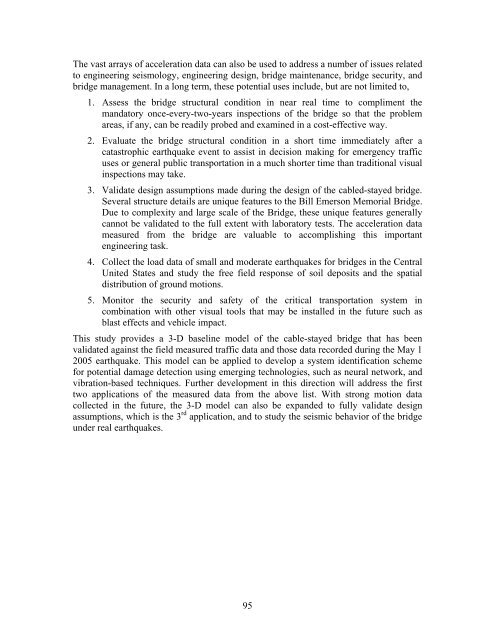Assessment of the Bill Emerson Memorial Bridge - FTP Directory ...
Assessment of the Bill Emerson Memorial Bridge - FTP Directory ...
Assessment of the Bill Emerson Memorial Bridge - FTP Directory ...
- No tags were found...
Create successful ePaper yourself
Turn your PDF publications into a flip-book with our unique Google optimized e-Paper software.
The vast arrays <strong>of</strong> acceleration data can also be used to address a number <strong>of</strong> issues relatedto engineering seismology, engineering design, bridge maintenance, bridge security, andbridge management. In a long term, <strong>the</strong>se potential uses include, but are not limited to,1. Assess <strong>the</strong> bridge structural condition in near real time to compliment <strong>the</strong>mandatory once-every-two-years inspections <strong>of</strong> <strong>the</strong> bridge so that <strong>the</strong> problemareas, if any, can be readily probed and examined in a cost-effective way.2. Evaluate <strong>the</strong> bridge structural condition in a short time immediately after acatastrophic earthquake event to assist in decision making for emergency trafficuses or general public transportation in a much shorter time than traditional visualinspections may take.3. Validate design assumptions made during <strong>the</strong> design <strong>of</strong> <strong>the</strong> cabled-stayed bridge.Several structure details are unique features to <strong>the</strong> <strong>Bill</strong> <strong>Emerson</strong> <strong>Memorial</strong> <strong>Bridge</strong>.Due to complexity and large scale <strong>of</strong> <strong>the</strong> <strong>Bridge</strong>, <strong>the</strong>se unique features generallycannot be validated to <strong>the</strong> full extent with laboratory tests. The acceleration datameasured from <strong>the</strong> bridge are valuable to accomplishing this importantengineering task.4. Collect <strong>the</strong> load data <strong>of</strong> small and moderate earthquakes for bridges in <strong>the</strong> CentralUnited States and study <strong>the</strong> free field response <strong>of</strong> soil deposits and <strong>the</strong> spatialdistribution <strong>of</strong> ground motions.5. Monitor <strong>the</strong> security and safety <strong>of</strong> <strong>the</strong> critical transportation system incombination with o<strong>the</strong>r visual tools that may be installed in <strong>the</strong> future such asblast effects and vehicle impact.This study provides a 3-D baseline model <strong>of</strong> <strong>the</strong> cable-stayed bridge that has beenvalidated against <strong>the</strong> field measured traffic data and those data recorded during <strong>the</strong> May 12005 earthquake. This model can be applied to develop a system identification schemefor potential damage detection using emerging technologies, such as neural network, andvibration-based techniques. Fur<strong>the</strong>r development in this direction will address <strong>the</strong> firsttwo applications <strong>of</strong> <strong>the</strong> measured data from <strong>the</strong> above list. With strong motion datacollected in <strong>the</strong> future, <strong>the</strong> 3-D model can also be expanded to fully validate designassumptions, which is <strong>the</strong> 3 rd application, and to study <strong>the</strong> seismic behavior <strong>of</strong> <strong>the</strong> bridgeunder real earthquakes.95
















